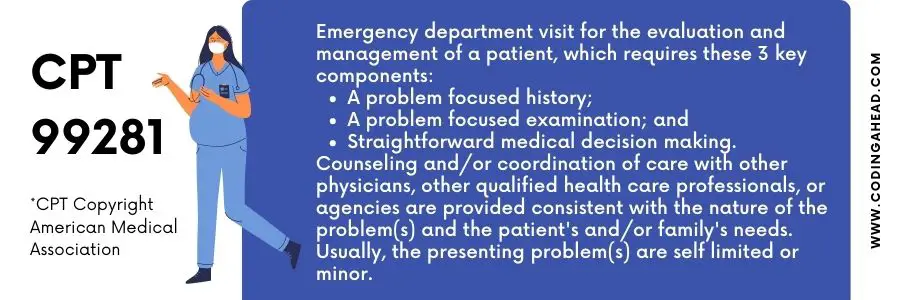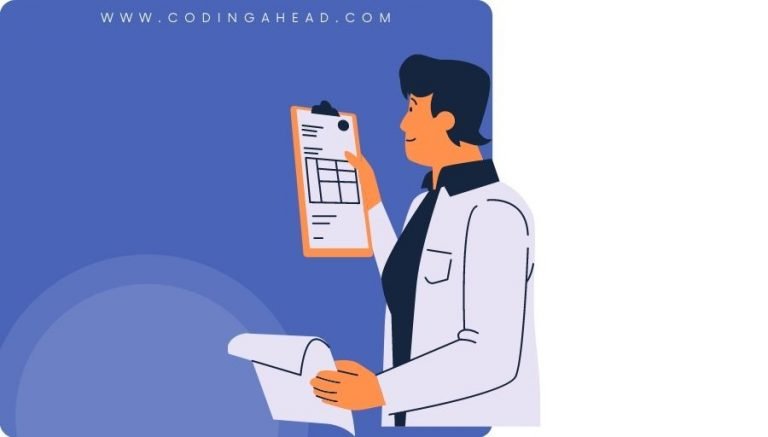99281 CPT Code (2022) | Description, Guidelines, Reimbursement, Modifiers & Example
The 99281 CPT code billing guidelines are explained in detail in this article, along with the commonly used modifiers, official description, and reimbursement.
Be aware that this code was revised on 01-01-2023. This article is about the previous version of the code description.
Code Description
There are five levels under the emergency department services category represented by 99281 CPT code to 99285. All decks require documenting the three key components (history, exam, and medical decision-making [MDM]).
Emergency Department (ED) codes are typically reported daily and do not differentiate between new or established patients.
Based on those three critical components 99281 CPT code is the lowest level of this series.
Three key components are required to evaluate and manage a patient who visited the Emergency Department: a problem-focused history, A problem-focused examination, and Straightforward medical decision-making.
Counseling & conciliation of care with other physicians, other health professionals, or agencies are provided consistent with the nature of the problem and clinical judgment. The patient’s or family’s needs are also included. Usually, the reporting problems are of low-level severity and Do not pose an immediate significant threat to life or physiologic function. Usually, the presenting issues are minor and self-limited.
The lowest level of care, 99281 CPT code, requires a problem-focused history and exam straightforward medical decision-making involving a minor or self-limiting complaint.

Coding Tips
This 99281 CPT code reports emergency department services for new or established patients. All three components (history, exam, and medical decision-making) must be met or exceeded for the level of assistance selected.
Time is not listed as a component in the code descriptors for all emergency department codes (99281-99285) as these types of services are provided based on the varying intensity of the patient’s condition and may involve emergency providers caring for several patients over an extended period involving multiple encounters, making it difficult for the clinician to accurately detail the amount of time spent face-to-face with the patient.
Physician services are provided for an emergency room (ER) visit, including medical decisions, Evaluation, and care.
An ED is typically defined as a standardized hospital-based facility providing unscheduled episodic services to patients needing urgent medical attention available 24 hours a day.
When selecting the E/M code 99281-99285, comorbidities and other underlying health conditions in and of themselves are not considered Until unless their presence significantly increases the complexity of the medical decision-making.
Three critical components within the limitations imposed by the necessity and urgency of the patient’s clinical condition and mental status are given below for the Evaluation and management of a patient in the Emergency department:
- Detailed history
- Detailed exam
- MDI (Medical decision making) of low complexity
- Reason for encounter
Billing Guidelines
Only one unit of 99281 CPT code is allowed to bill on the same day, effective from 04/01/2022.
E&M code 99281 is not reimbursable more than once to the same provider.
The Cost and total RVUs of CPT code 99281 are $22.15 and 0.64000
respectively for both National and Global Facility and Non-Facility Services.
Facility codes reflect the volume and ferocity of the facility’s resources to provide care.
While billing, Claims should be submitted with supportive Documents when requested by the provider to support the level of care rendered. The documentation must identify the low level of ED MDM and support ED E/M 99281 code billed. The documents that support it must be included in the appeal request if a denial is appealed.
Emergency service is provided to the patient by the physician and ED physician. If the ED physician, based on the advice of the patient’s physician who came to the ED to see the patient, sends the patient home, then the ED physician should bill the appropriate level of ED service.
The patient’s physician should also bill the level of code that describes the service He or She provided in the ED. If the patient’s physician does not come to the hospital to see the patient but only advises the ED physician by telephone, then the patient’s physician may not bill.
Coverage is applied to the conditions and limitations of an individual member’s programs and the Clinical Payment and Coding Policy criteria. The ED provides services to patients who need immediate medical attention. The physician or other qualified healthcare professional level of service is determined by the following:
Straight Forward Complexity (99281)
The presented problem is self-limited, with no medications or home treatment required.
ED visit for the Evaluation and management of a patient requires these three key components:
- A problem-focused history;
- A problem-focused examination; and
- Straightforward medical decision-making.
Reimbursement
Report place-of-service code 23 for services provided in the hospital emergency room.
For in-person Evaluation & management (E/M) services conducted in the emergency department (ED), emergency physicians can use the five ED E/M codes (99281 CPT code to 99825). Medicare and Medicaid cover emergency telehealth services. Reimbursement of telehealth in Medicaid varies by state.
For Medicare, here is the official guide for Covid-19:
Emergency physicians can perform telehealth services from anywhere, including the Emergency Department. CMS has added the Emergency E&M codes (99281-99285) to the approved Medicare telehealth/telecommunication services during the COVID-19 pandemic.
The POS 23 code for emergency telehealth services is the same as what would be used if the services were delivered in person. They should include modifier 95 to each claim to represent telehealth services.
The patient’s condition to ensure claims submitted with the correct level of service should be documented clearly. In some cases where the provider participates, co-payment, coinsurance, and deductible should be applied based on member benefits.
Billing Examples
The following are examples of when the 99281 CPT code may be used.
Example 1
Emergency department visit for a patient to remove sutures from a well-healed, uncomplicated laceration.
Example 2
Emergency department visit for the patient for tetanus toxoid immunization.
Example 3
Emergency department visit for a patient with several uncomplicated insect bites.




